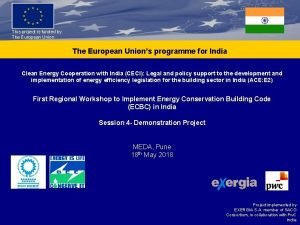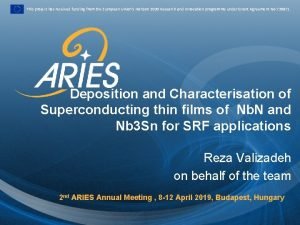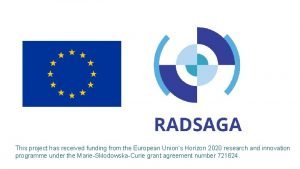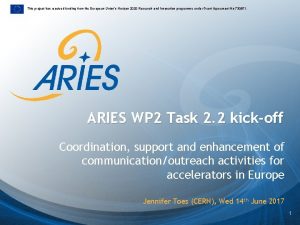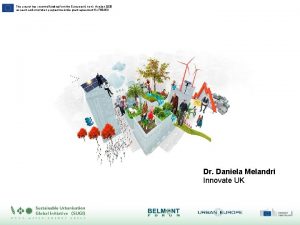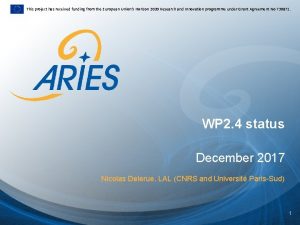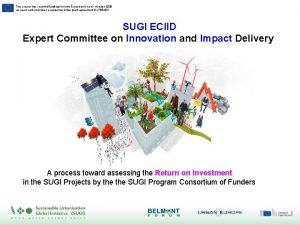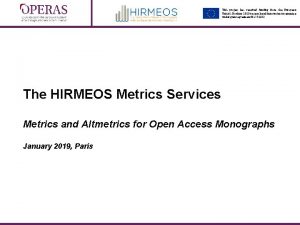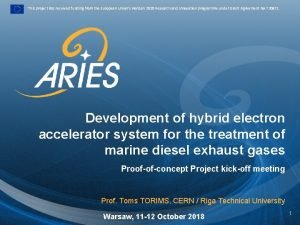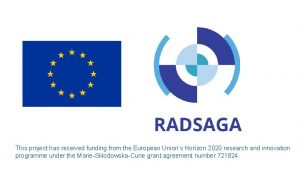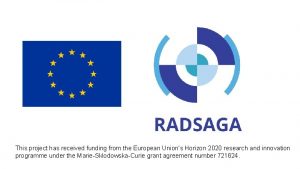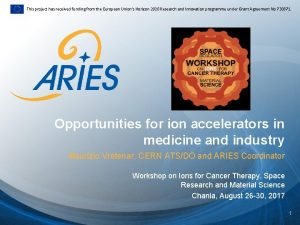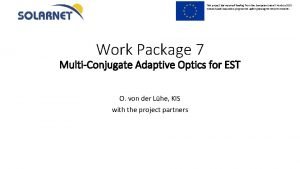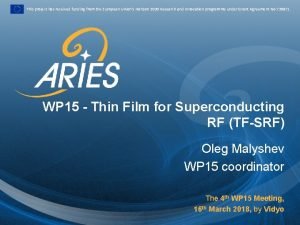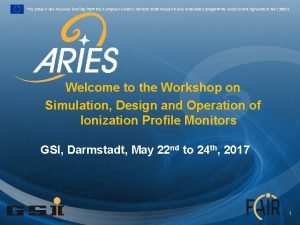This project has received funding from the European













![18 F Production • Most widely used pharmaceutical by far: 2 -[18 F]fluoro-2 -deoxy-D-glucose 18 F Production • Most widely used pharmaceutical by far: 2 -[18 F]fluoro-2 -deoxy-D-glucose](https://slidetodoc.com/presentation_image/8c2448f4dac8a131980c60047451a621/image-14.jpg)














- Slides: 28

This project has received funding from the European Union’s Horizon 2020 Research and Innovation programme under Grant Agreement No 730871. Accelerator Production of Novel Radioisotopes Rob Edgecock / University of Huddersfield & STFC 1

Radioisotopes • Used for imaging: - Positron Emission Tomography (PET) - Single Particle Emission Computed Tomography (SPECT) • Therapy: - brachytherapy • Process: - produce the isotope - extract and purify it - bind it to pharmaceutical - introduce into patient - decay used for imaging/therapy

Radioisotopes Two main diagnostic radioisotopes: PET

Radioisotopes Two main diagnostic radioisotopes: Single photon emitters - SPECT

Nuclear Imaging • Requirements § Must go where we want them § Must emit photons that can be detected § Half-life long enough for handling § Short enough that they don’t last too long § Manufacture costs not too high • Used currently most often: § SPECT: 99 m. Tc – 140 ke. V photons, 6 hour half-life § PET: 18 F – 2*511 ke. V photons, 2 hour half-life

Status

99 m. Tc Production • Made in (test) nuclear reactors § 99 Mo produced by fission of HE 235 U § ~6% of fission reactions § Mo is extracted in hot cells § Purified § Loaded into a “generator” § 99 m. Tc produced from Mo decay, half-life 66 hours

99 m. Tc Production • Until recently, done in 5 aging reactors • Variety of radiopharmaceuticals produced in hospital

99 m. Tc Production • Well-known 99 m. Tc problems due to (old) reactor production § Moly crisis in 2008/9 § Potential shortage in ≥ 2018 due NRU closure & LEU Various alternative production methods proposed, including accelerators

Accelerator Production Reaction: 100 Mo target 100 Mo(p, 2 n)99 m. Tc Proton accelerators 98 Mo Heavy nucleus target n 235 U target Particle accelerators 238 U Electron accelerators Deuteron accelerators Bremsstrahlung target Carbon target Primary particle Nuclear Energy Agency: direct production target Reaction: 98 Mo(n, γ)99 Mo Reaction: 235 U(n, f)99 Mo Reaction: 238 U(γ, f)99 Mo γ 100 Mo target n 100 Mo target Secondary particle 100 Mo(p, 2 n)99 m. Tc Reaction: 100 Mo(γ, n)99 Mo Reaction: 100 Mo(n, 2 n)99 Mo Short term: <2017 Med term: 2017 -2025 Long term: >2025

Accelerator Production • Tests done, mainly in Canada: - direct production using cyclotrons - photo-production using linacs TR 19: 14 -19 Me. V ~200 µA Popn ~2. 5 M TR 24: 24 Me. V, ~500 µA, popn ~4. 5 M

Accelerator Production • Tests done, mainly in Canada: - direct production using cyclotrons - photo-production using linacs • Technically looks feasible, but needs to be cost effective

PET Production • Pretty much all produced using a cyclotron • Main isotope: 18 F • Reaction: 18 O(p, n)18 F • 18 O enriched in water
![18 F Production Most widely used pharmaceutical by far 2 18 Ffluoro2 deoxyDglucose 18 F Production • Most widely used pharmaceutical by far: 2 -[18 F]fluoro-2 -deoxy-D-glucose](https://slidetodoc.com/presentation_image/8c2448f4dac8a131980c60047451a621/image-14.jpg)
18 F Production • Most widely used pharmaceutical by far: 2 -[18 F]fluoro-2 -deoxy-D-glucose (FDG) • Usually produced centrally and shipped to hospital • Much interest in shorter lived isotopes: § 11 C: ~20 min – C in all biological molecules § 13 N: ~10 min § 15 O: ~2 min • • Must be produced locally Needs compact/cheap accelerators

Therapeutic Radioisotopes • Mainly reactor produced • Supply can be a problem Courtesy: Uli Koester

Therapeutic Radioisotopes • Mainly reactor produced • Supply can be a problem • Some can be made by accelerator: - 177 Lu - 153 Sm • Some interesting isotopes need α: 211 At, 67 Cu, 47 Sc • Need to be cost effective: - right beam - right energy - high beam current

Therapeutic Radioisotopes 209 Bi(α, 3 n)210 At 209 Bi(α, 2 n)211 At

Technologies to be Studied • Fixed Field Alternating Gradient (FFAG) synchrotrons – SF cyclotrons • Two options being studied: - 0. 075 to 28 Me. V, ~20 m. A protons and ~1 m. A α - 1 Me. V to 35 Me. V, extraction at 1. 2 m • Both isochronous, normally conducting

Technologies to be Studied • Ongoing FFAG work – Injection – Extraction – RF – Errors – Reducing losses – etc

Technologies to be Studied • Compact linear accelerator (CERN) • Based on a high frequency radio frequency quadrupole Linac 4 RFQ at CERN Stolen from Maurizio Vretenar

Technologies to be Studied • Compact linear accelerator (CERN) 1 st high frequency module

Technologies to be Studied • Compact linear accelerator (CERN) Develop a modular high-frequency RFQ design covering 3 applications: 1. Injector for proton therapy linac 2. Isotope production in hospitals • 5 Me. V • Low current • Low duty cycle (<1%) • 10 Me. V • Low current • Medium duty cycle (<5%) • In construction • Design 3. Brachytherapy isotopes or Technetium production in dedicated • 20 Me. V centers • Includes DTL linac • High current • High duty cycle (10%) • Preliminary design

Technologies to be Studied 2 RFQs Input energy = 40 Ke. V Total Length = 4. 0 m Output Energy = 10 Me. V Frequency 750 MHz Average current = 20 m. A Peak current = 500 m. A Duty cycle = 4 % Peak RF power < 800 k. W Total weight (RFQ): 500 kg Mains power < 65 k. W Cooling ~ 100 l/min Production for PET scans of 18 F and 11 C ü ü No radiation around accelerator and target. Easy operation (one button machine). High reliability Minimum footprint (15 m 2)

Technologies to be Studied • Laser plasma acceleration • “Established” Target Normal Sheath acceleration Fields TV/m – TNSA (Target Normal Sheath acceleration) • “Evolving” Front surface acceleration – RPA (Radiation Pressure Acceleration) – Light-sail – BOA (Breakout after-burner) – Collisionless shock-wave acceleration –. . . L < tc/2 ~ 5 mm Recirculation, refluxing

Technologies to be Studied Clear 140 ke. V 99 m. Tc emission observed from the 100 Mo (p, 2 n) 99 m. Tc reaction & excellent half-life match Other isomers present include 95 m. Tc , 95 m. Tc, 94 Tc, 96 Tc, 93 Tc Calculations derive a 99 m. Tc activity of 0. 2μCi for a single-shot exposure. Based on a 10 Hz system operating at the levels produced, saturation yields of 675 m. Ci can be achieved using enriched 100 Mo. 22 m. Ci highest patient doses exceeded after < 20 min exposure times. Optimisation of proton beam could improve these figures. R. Clarke et al, SPIE Proceedings Vol 87791 C (2013)

Modelling 18 Me. V F Benard et al; Implementation of Multi-Curie production of 99 m. Tc by Conventional Medical Cyclotrons; J Nucl Med 2014; 55: 1017 -1022 Investigate the effect of bandwidth on the accelerated proton beam – maintaining acceptable contaminants Determine requirements of the source laser to be competitive in the future. TRIUMF analysis shows present isotopes post refinement are more critical than overall % refinement

Experimental Access Modify existing CLF ion spectrometers with adjustable slits for energy and bandwidth selection K. Leddingham et al 2004 J. Phys. D: Appl. Phys. 37 2341 Natural and refined moly samples will be used to confirm modelling & reaction pathways.

Conclusions • • Big field, lots of possibilities ARIES to investigate radioisotope production issues: • Compact sources for hospital-based production • Alternative routes for 99 m. Tc production • Alternative routes for therapeutic isotope production • Novel radioisotopes, especially for therapy Just starting, so plans still being finalised All are welcome to participate! 28
 Discuss the art of emerging europe
Discuss the art of emerging europe This project is funded by the european union
This project is funded by the european union This project is funded by the european union
This project is funded by the european union This project is funded by the european union
This project is funded by the european union This project is funded by the european union
This project is funded by the european union This project is funded by the european union
This project is funded by the european union This project is co-funded by the european union
This project is co-funded by the european union This project is funded by the european union
This project is funded by the european union Hình ảnh bộ gõ cơ thể búng tay
Hình ảnh bộ gõ cơ thể búng tay Frameset trong html5
Frameset trong html5 Bổ thể
Bổ thể Tỉ lệ cơ thể trẻ em
Tỉ lệ cơ thể trẻ em Chó sói
Chó sói Thang điểm glasgow
Thang điểm glasgow Alleluia hat len nguoi oi
Alleluia hat len nguoi oi Môn thể thao bắt đầu bằng từ chạy
Môn thể thao bắt đầu bằng từ chạy Thế nào là hệ số cao nhất
Thế nào là hệ số cao nhất Các châu lục và đại dương trên thế giới
Các châu lục và đại dương trên thế giới Công thức tính thế năng
Công thức tính thế năng Trời xanh đây là của chúng ta thể thơ
Trời xanh đây là của chúng ta thể thơ Mật thư anh em như thể tay chân
Mật thư anh em như thể tay chân 101012 bằng
101012 bằng Phản ứng thế ankan
Phản ứng thế ankan Các châu lục và đại dương trên thế giới
Các châu lục và đại dương trên thế giới Thơ thất ngôn tứ tuyệt đường luật
Thơ thất ngôn tứ tuyệt đường luật Quá trình desamine hóa có thể tạo ra
Quá trình desamine hóa có thể tạo ra Một số thể thơ truyền thống
Một số thể thơ truyền thống Cái miệng bé xinh thế chỉ nói điều hay thôi
Cái miệng bé xinh thế chỉ nói điều hay thôi Vẽ hình chiếu vuông góc của vật thể sau
Vẽ hình chiếu vuông góc của vật thể sau

